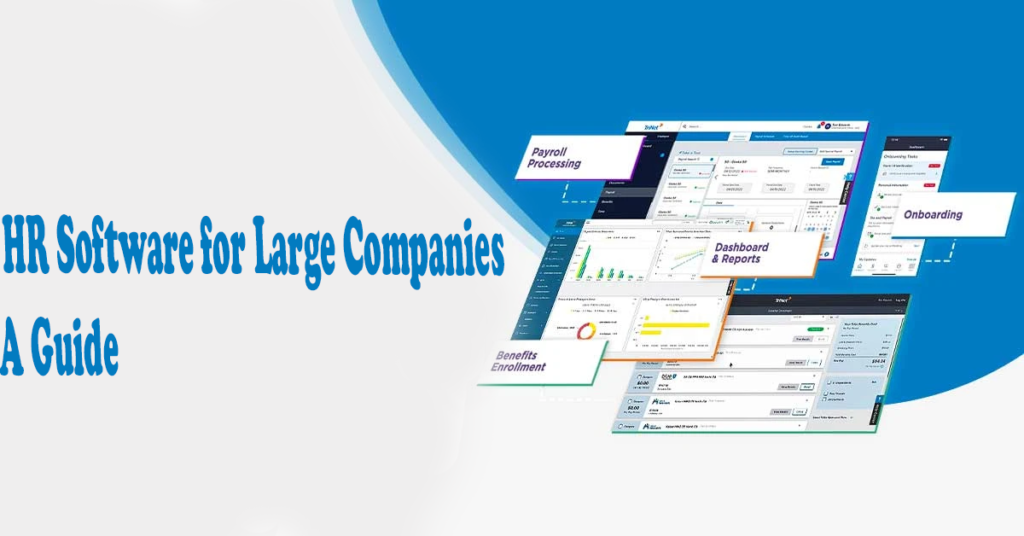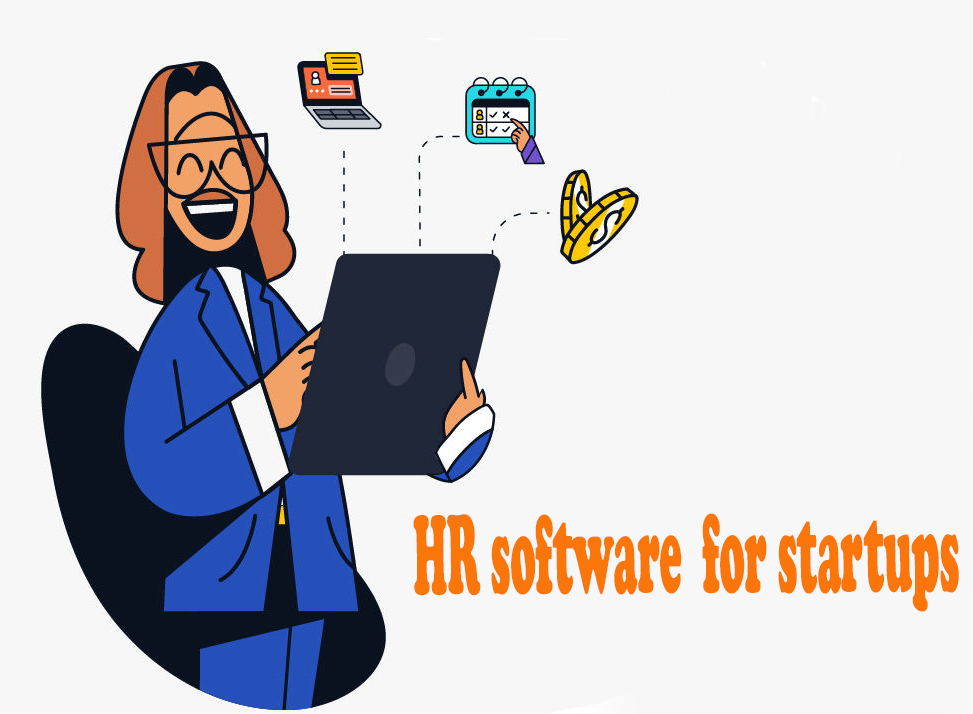HR software for large companies is becoming an essential tool in today’s fast-paced business environment. Navigating the complex HR landscape without a robust solution can be daunting.
A report by Grand View Research predicts that the global HR software market size will reach USD 30.9 billion by 2027, growing at a CAGR of 10.6%. This underscores the increasing reliance on these tools to streamline processes and manage human capital effectively.
Why is there such a surge in demand for HR software?
The modern workplace has evolved significantly with remote and hybrid work models becoming commonplace. HR software for large companies, equipped with features like mobile app access, employee self-service portal, document management, and remote collaboration tools have become indispensable to ensure smooth operation in such scenarios.
The Growing Importance of HR Software for Large Companies
As the business world evolves, large companies are recognizing more and more the value that human resources software brings to their operations. The global market for HR software is anticipated to attain a noteworthy USD 30.9 billion by 2027, exhibiting an annual growth rate of 10.6%. This upward trend underscores how vital these tools have become in streamlining HR processes and improving human capital management.
Modern-day HR platforms offer comprehensive solutions
These all-in-one systems automate many tasks traditionally handled manually by HR teams – from managing employee data and tracking time-off requests to overseeing performance reviews and administering benefits packages.
A Streamlined Approach To Human Resources Processes
An effective HR platform, at its core, simplifies various aspects of day-to-day operations within larger organizations’ departments. For example, recruitment becomes significantly streamlined with applicant tracking features, which help manage job postings across multiple channels while also keeping track throughout the hiring process.
Beyond just recruitment, other areas like payroll administration can be greatly simplified through integrated payroll software modules available on most modern platforms. These enable accurate calculations of even complex compensation structures, including bonuses or commissions, along with standard salaries, thereby reducing errors commonly associated with manual processing methods.
Elevating Human Capital Management With Strategic Capabilities
In today’s competitive landscape, the role played by HR professionals extends beyond mere administrative functions to strategic elements involving talent acquisition and retention strategies, alongside fostering a positive employee experience among other factors influencing overall company success. Hence, it’s crucial that their efforts aren’t bogged down due to mundane tasks that could otherwise be automated via a suitable system.
This is where the right HCM (Human Capital Management) software comes into play, not only meeting current needs but also scaling up as per future requirements, thus effectively future-proofing businesses against potential challenges down the line.
Selective Truths About Advanced Analytics And Workforce Trends:
Few things stand out when discussing advanced analytics offered by some top-tier information systems (HRIS). By providing insightful workforce trends and productivity patterns, they empower decision-makers with
Key Takeaway:
HR software is no longer a luxury but a necessity for large companies, streamlining operations from recruitment to payroll. It’s not just about automating mundane tasks, it’s about elevating human capital management and future-proofing businesses with strategic capabilities and advanced analytics.
Adapting to Remote and Hybrid Work Models with HR Software
The rise of remote work has made it essential for businesses to adapt their human resources management system. With the right HR software solutions, companies can streamline operations in a remote or hybrid environment.
This is where robust HR platforms come into play.
According to the Better Buys report, 57% of professionals consider mobile access crucial when selecting an HRIS software.
To stay competitive in today’s digital landscape, you need tools that facilitate smooth operation, such as an employee self-service portal and document management capabilities. But more than just facilitating basic tasks, your chosen platform should also promote engagement among employees regardless of location.
Enhancing Employee Engagement In Remote Settings
An engaging user interface on these platforms can provide easy-to-use communication tools.
In addition to this interactive feature set up by modern-day applications designed keeping in mind both desktop-based use cases as well as the ability to cater to the needs of a workforce increasingly reliant upon digital technologies to carry out daily responsibilities effectively and efficiently as possible.
Regular feedback cycles facilitated by the performance management features allow managers to recognize achievements promptly while providing constructive guidance where necessary, even if they’re not physically present at the office – maintaining morale during long periods spent working remotely under hybrid conditions.
This continuous dialogue fosters a culture where employees feel valued, which is crucially important.
Mobility: A Key Feature Of Modern HRIS Software
With the fast-paced world, flexibility is key, and having mobile access as part of the chosen information system isn’t desirable—it’s essential, according to the Better Buys report. 57 percent consider this factor when selecting an HR platform.
Offering comprehensive functionality via smartphones and tablets—such as allowing users to request leave or days off directly through their devices—the right kind of HCM solution can help streamline administrative tasks while simultaneously improving overall productivity levels for teams operating remotely.
These points underscore the importance of leveraging technology to drive inclusivity within evolving models and future-proofing your business against potential challenges that might arise from the shift towards flexible workplaces.
Key Takeaway:
Adapting to remote work demands a robust HR software. Key features should include mobile access, an engaging user interface and performance management tools that foster continuous dialogue. This not only streamlines operations but also boosts employee engagement in hybrid environments.
Key Considerations When Selecting HR Software for Large Companies
Selecting the ideal HR software is a pivotal decision that has significant ramifications on your organization’s operational efficiency. When selecting HR software, various elements must be weighed.
The first consideration should always be scalability.
Your business will grow and evolve, as will its human resources needs. The chosen HCM (Human Capital Management) software must possess the capability to accommodate this growth without causing disruption or necessitating substantial additional investment, thus future-proofing businesses against potential challenges.
Importance of Mobile Access in Modern HRIS Software
Mobile access is no longer a desirable luxury, but an absolute necessity for modern HRIS software. With 57% of HR professionals considering mobile access crucial when selecting Human Resources Information Systems (HRIS), it becomes clear that modern workplaces demand flexibility and accessibility from their HR platforms.
An effective human capital management system should offer seamless integration with existing systems like Enterprise Resource Planning (ERP) or Customer Relationship Management (CRM). This ensures smooth data flow across different departments and minimizes redundancy while improving overall productivity.
User-Friendliness & Reporting Features
Beyond technical aspects lies another critical factor – user-friendliness. An intuitive interface makes navigation easier for all users – from HR leaders down to individual team members – thereby increasing usage rates and maximizing return on investment. Moreover, comprehensive reporting capabilities provide valuable insights into various aspects such as talent management performance or benefits administration effectiveness, which can help drive strategic decisions at the executive level.
A final yet vital aspect often overlooked during the selection process is the security measures implemented by software vendors. With sensitive information being handled by these systems – ranging from payroll details to personal employee data – robust security features are paramount for maintaining trust within the workforce and ensuring regulatory compliance.
Key Takeaway:
Choosing the right HR software for large companies requires considering scalability, mobile access, integration with existing systems, user-friendliness and reporting features. Don’t forget to check out security measures too – it’s not just about smooth sailing but also safe harbor.
Boosting Diversity & Inclusion with the Right HR Software
In today’s competitive business environment, diversity and inclusion (D&I) are not just corporate buzzwords. They have evolved into vital components of an organization’s culture that significantly influence its success. The right human resources software can be a game-changer in promoting D&I by ensuring unbiased hiring processes and fostering inclusivity throughout the employee lifecycle.
The ideal HR platform goes beyond mere compliance with equal employment opportunity laws. It aids organizations in proactively building diverse teams using features like impartial screening tools, anonymized applications, and comprehensive reporting capabilities for effectively tracking D&I metrics.
Leveraging Applicant Tracking System for Greater Workplace Diversity
An applicant tracking system (ATS), when used correctly within your chosen Human Capital Management software or HCM software as it is commonly known, becomes one of the most potent tools in enhancing workplace diversity. According to Forbes, ATS automates several aspects of the recruitment process, thereby minimizing unconscious bias from influencing hiring decisions and leading to a more diversified workforce selection.
This advanced feature allows large companies’ HR departments to focus solely on candidates’ qualifications rather than demographic information such as age or gender during initial screenings, thus facilitating fairer talent acquisition strategies while also efficiently meeting their respective diversity targets.
Beyond simply anonymizing applications, some cutting-edge ATSs offer inclusive job description builders that aid in crafting neutral job descriptions devoid of any biased language, hence attracting a wide array of talent across different backgrounds and further boosting the company’s efforts towards achieving better D&I outcomes over time.
To assess effectiveness over time, many modern-day ATSs provide detailed analytics about your recruitment funnel, highlighting areas where there might be drop-offs for certain groups, enabling you to make data-driven improvements along with actionable insights. LinkedIn suggests this approach provides clear visibility into how well your current strategies are working towards creating a diversified workforce while indicating areas needing improvement if any exist.
In essence, leveraging these functionalities embedded within an ATS ensures adherence to best practices when recruiting diversely,
Key Takeaway:
Choosing the right HR software can supercharge your company’s diversity and inclusion efforts. With tools like unbiased screening, anonymized applications, and comprehensive reporting capabilities, you’re not just complying with laws—you’re proactively fostering a diverse workforce. An Applicant Tracking System (ATS) is your secret weapon in this mission—automating recruitment to minimize bias and providing crucial data for
Future-proofing Your Business with the Right HCM Software
The strategic decision to select the right Human Capital Management (HCM) software can make or break your company’s future. A robust HCM solution that meets current needs and scales up as per evolving requirements is key to ensuring long-term business success.
Your HR processes, performance management, payroll systems, benefits administration – all these functions are streamlined by an efficient HCM system.
Benjamin Franklin once said, “By failing to prepare, you are preparing to fail.” The same principle applies when selecting your HR platforms. It’s not just about meeting present needs but also anticipating what lies ahead. With advanced features like analytics capabilities at their disposal, modern solutions provide valuable insights into employee engagement levels, enabling proactive talent management decisions.
Role Of Vendor Support And Training In Successful Software Implementation
A smooth transition from old systems requires more than a feature-rich product; it calls for strong vendor support during implementation and beyond. This partnership ensures minimal disruptions while adapting new tools, thereby optimizing daily operations of large companies.
An investment in training programs offered by vendors equips your HR staff with necessary skills, maximizing return on investment through effective utilization of the platform functionalities.
Vendors who demonstrate commitment towards customer success post-purchase play a pivotal role too. Their ongoing technical support addresses issues promptly, enhancing user experience over time, besides offering regular updates for security enhancements and feature improvements.
Picking out optimal human resources information systems involves careful consideration of scalability aspects along with assessing vendor support mechanisms available post-purchase. This comprehensive approach will ensure the selection of an apt solution capable of growing alongside organizational changes, thus securing businesses against unforeseen challenges down the line.
Key Takeaway:
Choosing the right HCM software is a strategic move that can future-proof your business. It’s not just about current needs, but also anticipating and adapting to what lies ahead. Strong vendor support and training are equally crucial for successful implementation and maximizing ROI.
Conclusion
The significance of HR software for large companies is growing at an unprecedented pace.
These platforms are now integral to adapting and thriving in the new era of remote and hybrid work models.
Selecting the right solution involves careful consideration, with factors like scalability, customization, integration capabilities, security measures, and user-friendliness all playing a crucial role.
Diversity and inclusion have become non-negotiable aspects that your chosen software must address effectively.
Leveraging integrated systems such as learning management or payroll within your human resources platform can further streamline operations while fostering employee development.
A future-proof HCM software not only meets current needs but also scales up as per future requirements.
If you want to learn more about this, sign up for my newsletter.
Read More:
HR software for startups: Transforming Startups


